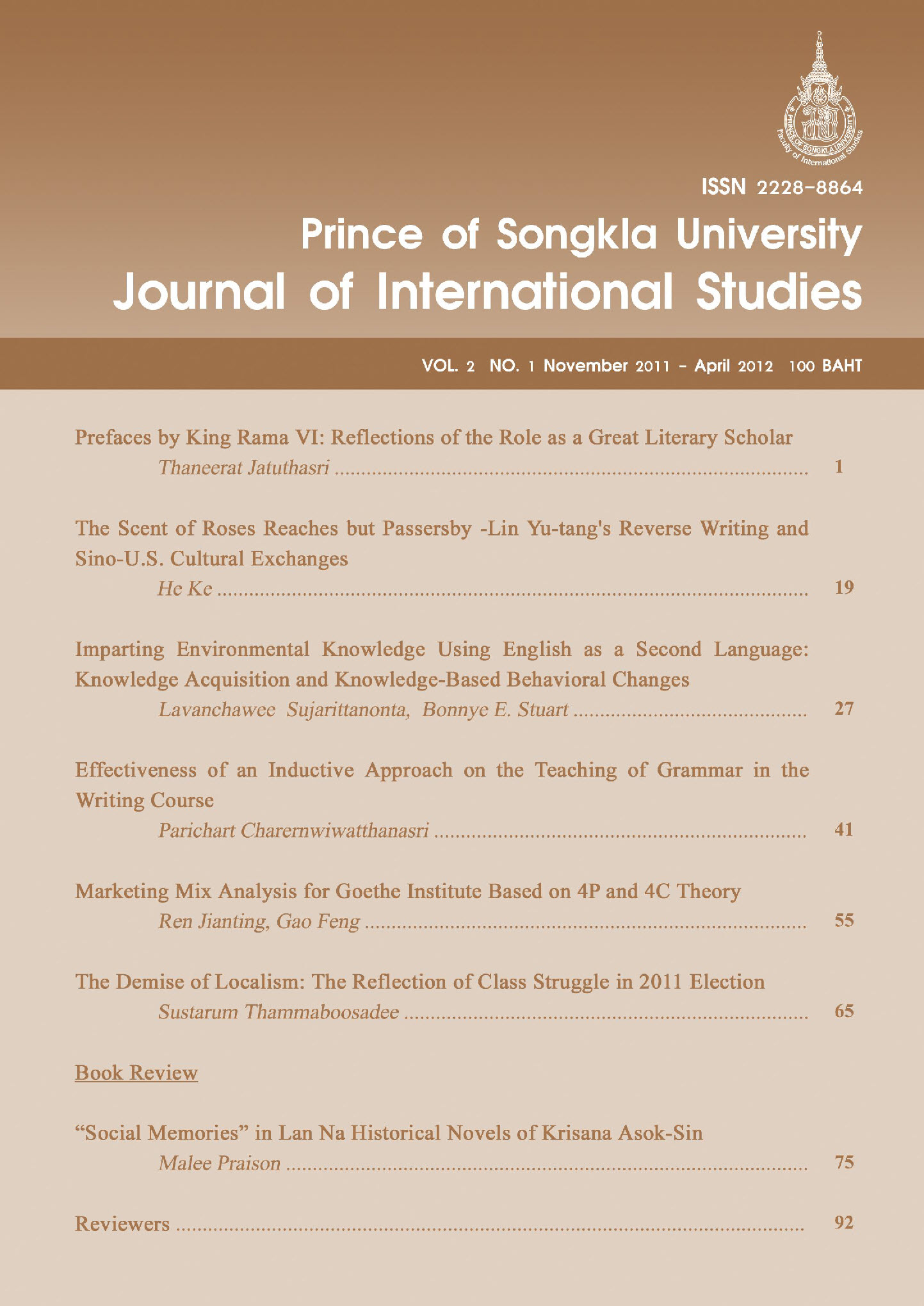Effectiveness of an Inductive Approach on the Teaching of Grammar in the Writing Course
Main Article Content
Abstract
The purposes of this research were: 1) to study whether the use of the inductive coroach can improve students' grammatical errors in the writing course at Suratthani Raiabhat University 2) to investigate issues in grammatical errors in the texts written by the second year English major students at Suratthani Rajabhat University and 3) to find out students' attitudes towards learning grammar through an inductive approach. The subjects of this study were 80 second year students majoring in English, Faculty of Education at Suratthani Rajabhat University, Suratthani Province. This research was conducted in the first semester of academic year 2009 in the writing course, 182573 Formal Paragraph Writing. They were selected based on their same levels of achievement in English skills and were put into 2 groups: the experimental group and the control group. The experimental group was taught with 17 grammatical items by using the inductive approach, while the control group was taught with the same 17 grammatical items without the inductive approach. The writing skills were also taught in all classes. Four research instruments were used in this study: the pre-test consisting of 100 items of multiple choices grammar test and the writing test for both group; the inductive approach treatment designed in forms of lesson plans for the experimental group; the post-test for both groups and; the questionnaire determining experimental group students' attitudes towards learning grammar through an inductive approach.
The findings showed that the inductive approach positively affected the teaching of grammar in the writing course. The mean scores of the post-test in the experimental and control groups were significantly different at the 0.01 level. This indicates that the students who were trained through the inductive approach had the significantly higher rateof knowledge than did the students who were taught with the common lessons through the regular lectures. After the treatment, there were differences on frequencies of error occurrences between both groups, that is, the experimental groups did significantly better in the post-tests than in the pre-test. This showed that the inductive approach, through the writing classes, could improve learners' grammatical errors. It was also found that there were totally 25 issues of grammatical errors which were frequently produced by t1 its ranking from sentence to word levels. These issues of errors were about verbs the first language interference, the use of pronouns, the use of nou he use of pronouns, the use of nouns, possessives the orarticles, prepositions, agreement of subject and verbs, word order, gerund, subject pr nent language, phrasal verbs, conjunctions, infinitives, relative clauses, incomplete tences, adjectives, modals, there-be, run-on sentences, comparison, voices, if clauses the use of adverbs. From the findings, students possessed high positive attitudes towards learning English grammar through an inductive approach. Teaching and learning English grammar through an inductive approach was considered satisfactory in the students' opinions
Article Details
Statements and opinions expressed in articles herein are those of the authors and do not necessarily reflect the position of the editors or publisher.
Article, information, text, image, etc. which are published in Journal of International Studies, belong to Journal of International Studies. If anybody or any organization would like to use part or whole of them, they must receive written permission from Journal of International Studies before usage.
References
grammatical competence of M.4 students in science program at Nawamintha Taksin school, Songkhla. Unpublished master's thesis, Prince of Songkhla Un
Thailand Basic Curriculum B.E. 2544. (2001). Contents and standards of learning for a
foreign language. Bangkok: The Ministry of Education. Brown, H.D. (2000). Principles of language learning and teaching, 4th ed.,
Englewood Cliffs, NJ: Prentice Hall Regents. Coulter, S.P. (1983). Second language learning: Contrastive analysis, error
analysis, and related aspects. Ann Arbor, MI: University of Michigan Press. Felder, R., & Henriques, E. (1995). Learning and teaching styles in foreign and
second language education. Foreign Language Annals, 28(1), 21-31. Fischer, A. R. (1979). The inductive-deductive controversy revised. Modern
Language Journal, 63(3), 98-105. Goner, Phillips & Walters (1995). Teaching practice handbook: structures:
grammar and function. London: Heinemann Jack C. R. (1993). Longman dictionary of language teaching and applied
linguistics. Singapore: Longman Group UK Limited. Krashen, S. (2002). Second language acquisition and second language learning.
Retrieved January 11, 2006, from http://www.sdkrashen.com/SL_Acquisition
and Learning Paradowski, M. B. (2007) Exploring the L1/L2 interface. A study of Polish
advanced EFL learners. Institute of English Studies, University of Warsaw, Pongsiriwet, C. (2001). Relationships among grammatical accuracy, discourse
features, and the quality of second language writing: The cause of Thai EFL learners. Unpublished doctoral dissertation. West Virginia University, United
State of America. Puntakerngamorn, P. (1999). English language education in secondary schools in
Thailand : a Thai cultural perspective. Unpublished master's thesis. Nova
Southeastern University, United State of America. Rivers, W.M. & Temperley, M.S. (1978). A Practical guide to the teaching of
English as a second or foreign language. Oxford: Oxford University Press. Shih, J.Y. (2008). Effects of inductive and deductive approaches in grammar
instruction for junior high school students of differing English proficiency.
Unpublished master's thesis, Technology in Southern Taiwan, Taiwan. Sun, Y.C. & Wang, L.Y. (2008). Concordancers in the EFL classroom:
Cognitive approaches and collocation difficulty. Taiwan: National Chao-Tung
University.
Winter. (1989). A comparison of inductive and deductive approaches to teaching
foreign languages. Modern Language Journal, 73(4), 395-403


